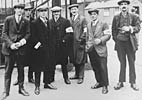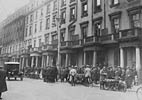In the days after May 12, the TUC received angry protests about the way the Strike had been called off and there were grave problems with victimisation against strikers. Many workers, notably on the railways, refused to return to work until the owners had withdrawn threats to their conditions and contracts. All unions that had taken sympathetic action suffered financially due to their finances being seriously depleted by the amounts paid out in strike pay or unemployment benefit.
The miners rejected the 'settlement' entirely and were left, for six gruelling months, to fight on alone until they were starved back to work. During this time a breakaway right wing association of miners in Nottinghamshire under the leadership of G.A. Spencer (a right wing Labour MP who had opposed the strike), split away from the Miners Federation. At the end of November, the Federation was forced to give in - wages were cut and fixed on a district rather than a national basis. There was no longer a minimum wage and hours were extended to 8 hours per day.
There was an inquest into the TUC's handling of the Strike at a Conference of Executives in January 1927. Both the General Council and the Miners' Federation each tried to defend their actions and there was some discussion of organisational weaknesses. The General Council's report was endorsed by a large majority - but the conference was a formality and did nothing to combat the bitterness and controversy over the way in which the strike had ended.
Christine Coates, TUC Library Collections Librarian
Click here to view documents and pictures








